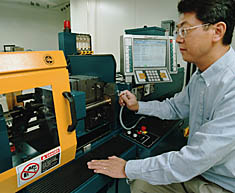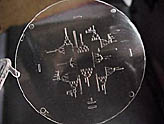"BioMEMS Research Produces Mini-Medical Monitor"
May 18,
2001, Research News
UC's Microsystems and BioMEMS Laboratory at the Center for
Microelectronic Sensors and MEMS (CMSM) is attracting millions of
dollars in federal funding and attention from researchers around the
world, but the projects coming out of the lab are even more amazing.
Working with major corporations and other high-tech universities,
College of Engineering researchers are on the verge of developing a
wristwatch-like device that can monitor everything from a patient in
intensive care to a wounded soldier on a distant battlefield, using
disposable smart plastic biochips.

"This is an amazing story," said Chong H. Ahn, associate
professor in electrical and computer engineering and computer
science and director of the Microsystems and BioMEMS Lab. "UC has
made the greatest strides. It's one of the most successful programs
in the country," alongside MIT, Stanford, the University of Michigan
and UC-Berkeley. Ahn said UC engineers are making a strong impact in
three areas involving MEMS technology, which stands for
micro-electromechanical systems:
Magnetic MEMS BioMEMS Nano Biochips
"We belong to the top tier," said Ahn, who has letters from top
research directors at the National Science Foundation and elsewhere
documenting that his novel inventions and excellent publications
"put UC on the map" in the rapidly growing MEMS and BioMEMS fields.

Ahn is a leader at numerous international conferences on BioMEMS
and MEMS, where he has demonstrated how to make micro biochips out
of plastic. That research has moved forward quickly and is now
focusing on the development of a wristwatch-like device to monitor
blood chemistry.
"There is no pain in blood sampling," he notes. That's because
microscopic needles made of biodegradable plastic materials are used
to quickly pierce the skin and retrieve the tiny amount of blood
needed for analysis. The analysis uses "smart, plastic biochips,"
which are extremely sensitive, inexpensive, disposable and fast.
"We can analyze almost anything in 10-20 seconds with a tiny
drop of blood," said Ahn. Traditional lab tests can take hours
with the blood sample using a big syringe, and patients often wait
days for results. Collaborators include researchers at Ohio State
University, Louisiana State University, Meridian Diagnostics Inc.
and CFD-RC.

One of the novel features of the system is the way it reduces
energy consumption by using a pressured air or liquid on a biochip,
as an alternative power to electronic batteries. Tiny bubbles in the
biochips are "popped," releasing a blast of air in a sequence to run
the various channels, mixers, incubators, sensors and valves
required for analysis on a chip. Since the biochips are disposable,
it doesn't matter that the bubbles burst. Just pop in a new chip,
and you're ready to run the next series of tests.
DARPA (the Defense Advanced Research Projects Agency) is funding
the project in hopes of being able to get a quick read on the
condition of soldiers wounded in battle or of various clinical
screening and diagnostic applications. "The army would be able to
monitor a soldier's condition during the operation. Is he going into
shock due to bleeding or respiratory difficulty? You could judge by
the biochips with remote communication."
Because the basic technology has been worked out, the monitor
could easily be adapted to check for a number of different compounds
including lactate, glucose, carbon dioxide and oxygen levels in the
blood, including detection of infectious diseases using immunoassay.
That means the wristband monitor could be used as a point-care
system in hospitals or to monitor outpatients.
Ahn's progress has been so remarkable that he has been invited to
over 15 international meetings in addition to invited talks at top
U.S. labs. He says the "real success story" though is the number of
engineering graduate students succeeding in the new field of
BioMEMS. They have produced nearly 100 papers in some of the world's
top journals and major international conferences in MEMS and
BioMEMS, including one U.S. patent issued and eight U.S. patents
pending. After earning their degrees, they have gone to positions at
AT&T Bell Labs, Motorola, Samsung and new biotech start-up
companies.
In addition, he has been extensively working on the development
of "lab-on-a-chip" using glass or plastic substrates to detect and
analyze bio-molecules such as specific proteins and/or antigens in
liquid samples. The methodology and system, which has been developed
on disposable plastic substrates, can be also applied to generic
bio-molecule detection and analysis systems with appropriate bio
receptors/reagents such as DNA fragments or oligonucleotides for
genomic analysis and/or high throughput protein analysis.
He is now working with several medical doctors and cell
biologists from the UC College of Medicine for applying the
disposable plastic or glass biochips to genomics and proteomics
research, including cell-based biochips. His lab and the CMSM are
now fully equipped to fabricate micro- or nano- structures for
biochips and BioMEMS devices using plastic, glass and silicon
substrates. Specifically, his recent DARPA project allows his lab to
be equipped with state-of-the-art plastic micromachining tools such
as a micro molder fabrication system, a micro plastic
injection-molding system, a plastic embossing system, a wafer
aligning and bonding system, a laser micromachining system, a
plastic surface analyzer and more.
It's even possible that some of the inventive work done in the
College of Engineering will spawn a new biotech company through the
initiatives of the Office of Intellectual Property. But Ahn is quick
to acknowledge the ideas and efforts of his fellow engineering
faculty members, which includes electrical engineering's Joseph
Nevin, who has worked on circuit designs, and Gregory Beaucage in
material science and engineering, who has developed the polymers
required for the plastic biochips. Both are co-PIs on the
DARPA-funded project, which will be performed for the next three
years.
"This is one of the most successful examples of teamwork at
UC," said Ahn. "The success is not mine alone. It's an
interdisciplinary collaboration with many partners throughout the
University of Cincinnati."
For more information, check out Ahn's web site at www.biomems.uc.edu.
Cited from Research
News
|